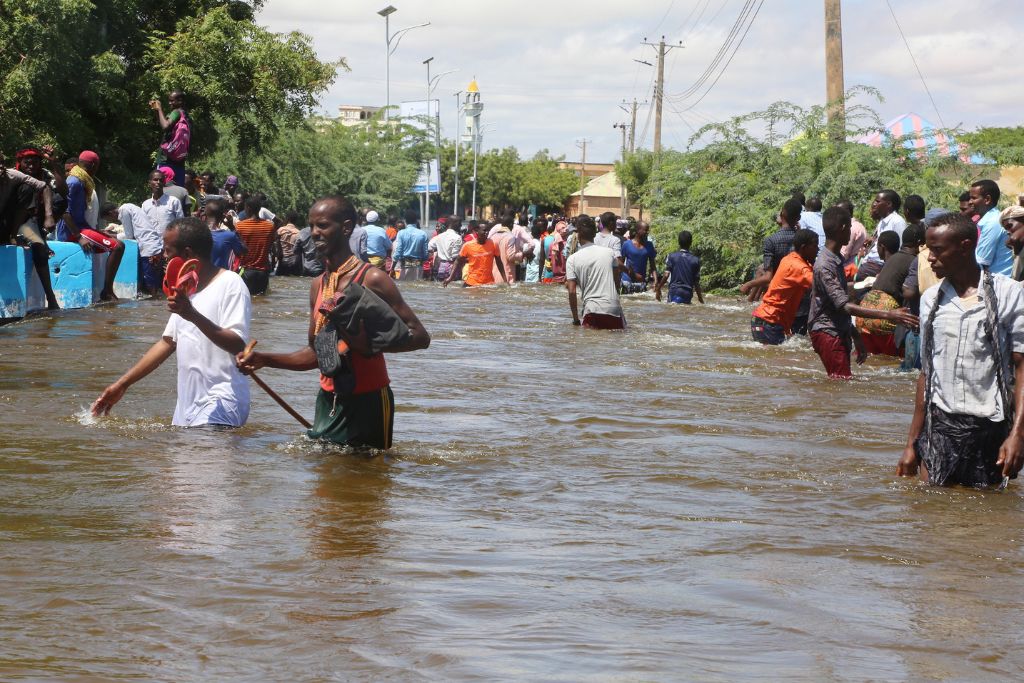As the Horn of Africa confronts its most severe drought in recent history, populations across Ethiopia, Kenya, and Somalia face another threat: floods. Even as the region contends with the historic drought, sporadic rains in some areas have caused devastating flooding and compounded the drought’s impacts, decimating livestock and livelihoods. Prolonged and extreme dry conditions increase the risk of flash floods, trapping communities in a drought-flood cycle as climate change leads to longer, more frequent, and more severe droughts.
—
Droughts Create Ideal Conditions for Floods
The drought conditions that have made rainfall so crucial are counteracting its potential benefits in the region. The three-year-long drought led to extremely dry and hardened land, affecting soil’s ability to absorb rain.
Soil is most absorbent when damp, as moisture changes its porosity and creates the ideal conditions for more water to enter. In contrast, dry earth can form an impermeable layer that repels water. After extensive drought, intense rainfall can also wash away crops and topsoil, negating the favourable impacts of rainfall on crop conditions and agricultural livelihoods.
You might also like: The Negative Impacts of Flooding on the Planet
Heavy Rainfall After Years of Drought Led to Flash Floods Across the Horn of Africa
Early forecasts in February indicated that the Horn of Africa’s gu long rains season, which typically extends from March to June, would likely underperform, prolonging the dry conditions. However, a shift in climatic conditions in March led to a revised forecast, which predicted average or above-average rainfall across the Horn at the peak of the rainy season, according to the Famine Early Warning Systems Network (FEWS NET).
The onset of the rainy season in March resulted in heavy rains in certain areas, which provided much-needed moisture and led to some improvements in pasture and water resources. At the same time, the periodic heavy rainfall generated flash floods that affected hundreds of thousands of people in Ethiopia, Kenya, and Somalia.
In Somalia alone, floods caused by the gu rains in March affected more than 450,000 people and forced nearly 220,000 people from their homes, according to initial estimates by the United Nations. Somalia’s Shabelle river overflowed its banks, suddenly flooding surrounding villages, washing away homes and destroying farmland. The floods also swept away scores of livestock that had survived years of drought – a devastating blow to already dwindling herds.
Relief actors have warned that if heavy rains continue in Somalia and the Ethiopian highlands, flooding could adversely affect up to 1.6 million people and displace more than 600,000 people living in flood-prone areas. The floods only add to the suffering in Somalia, where drought forced an estimated 1.3 million people from their homes in 2022.
Years of Recovery Ahead as Climate Change Increases Risk of Severe Weather Events
Although the rains in Somalia and across the Horn are recharging surface water sources and offering some relief, the UN assesses that much more rainfall is needed to alleviate the effects of the drought.
“Recovery from six consecutive seasons of poor rainfall performance will take time,” the UN said in a report published in May 2023.
Regardless of the performance of the ongoing rainy season, the scale, severity, and magnitude of the suffering due to the region’s drought will take years to fully recover from, the UN asserts. Many households have lost entire livestock herds, while others have no resources to invest in restoring their farmlands when rains do return. Moreover, when the multi-year drought started in the Horn of Africa in 2020, many pastoral households were still recovering from previous droughts that struck the region in 2016/2017 and 2010/2011. The high level of need among households that lost most of their resources, coupled with the severe degradation in environmental conditions, means that recovery will take several seasons—or even years—of good rainfall performance, according to FEWS NET.
As the Horn of Africa becomes hotter and drier, the frequency of dry spells, seasonal droughts, and multi-year droughts, as well as episodes of torrential rainfall, have increased, according to the UN. A recent study published by the World Weather Attribution initiative in April concluded that climate change contributed to the drought in the Horn by leading to higher temperatures, which significantly increased the amount of water evaporating from plants and soils. With the increased risk of extreme weather events, communities across the Horn will continue to face the threat of protracted drought punctuated by destructive rains even after the ongoing drought concludes.
Featured image: UNSOM/Flickr
You might also like: Climate Change Made Horn of Africa Drought 100 Times More Likely: Study


















